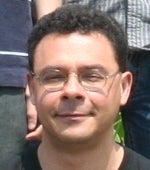
Luis Ibáñez works as Senior Software Engineer at Google Inc in Chicago. Opinions expressed in this site are his own.You can find him in github at: http://www.github.com/luisibanezand in twitter at: http://www.twitter.com/luisibanezHe previously worked as a Technical Leader at Kitware Inc., and Director of Open Source Community Development at the Open Source EHR Agent (OSEHRA). At Kitware he was closely involved in the development of open source software for medical imaging applications, in particular, working with the Insight Toolkit (ITK).Luis is a strong supporter of Open Access, and one of the editors of the Insight Journal, an OA Journal that enforces the verification of reproducibility. In collaboration with other instructors, Luis taught a course on Open Source Software Practices at RPI between 2007 and 2013, and also at the State University of New York at Albany between 2011 and 2014.Luis Ibáñez received a B.S. in Physics from the Universidad Industrial de Santander (Bucaramanga, Colombia) in 1989 and a M.S. in Optics from the same university in 1994. He received a D.E.A and Ph.D. degrees from the Universite de Rennes I (Rennes, France) in 1995 and 2000, respectively. In 1999, Luis Ibáñez joined the Division of Neurosurgery of the University of North Carolina at Chapel Hill and participated as a member of the MIDAG and CADDLab groups. His work at UNC was related to the development of algorithms for 2 and 3D registration applied to image guided surgery. He also participated as developer of the INSIGHT Registration and Segmentation Toolkit sponsored by the National Library of Medicine. Luis Ibáñez joined Kitware, Inc. in February 2002 where he was one of the main developers of the Insight Toolkit (ITK) coordinating its maintenance with other developers and the user community; he is also one of the main developers of the Image Guided Surgery Toolkit (IGSTK) and participated in crafting the operational principles of the Insight Journal. Luis Ibáñez is a strong supporter of Open Access, and the verification of reproducibility in scientific publications and is a regular speaker in ITK training courses, and in events disseminating the principles of Open Source. In August 2014, Luis joined Google Inc as Software Engineer, to work with the corporate engineering team in New York city.

Authored Comments
Brian,
Thanks for your comments.
It is very interesting to hear your observations about the tensions between open source and closed source in the space of educational tools.
I have been using Moodle for three years now in our Open Source Software Practices class at RPI. Your comments certainly resonate with my experience.
One good way to consolidate those tensions is by letting the software be a service delivery platform, and be open source, while generating revenue through business models based on hosting and delivery of services.
This is the Power Grid model, where the power grid is a service delivery platform, over which Electric Power producers deliver energy to the final consumers. The Power Plants do not need to own, nor control the power grid. They just needed it to be there, to be healthy and to be available. In this metaphor, open source software is like the power grid, while the services that are delivered through the software are equivalent the the electric energy that flows through the grid. Customers do not pay for licenses to the grid, they pay for the delivery of energy. In the process, a fraction of revenues generated through services is used to maintain an improve the power grid.
In the case of the course management systems, such as Moddle (open source) and Blackboard (closed source), the final interest of the educational institution is to have a deployed working system. Having service providers offer the hosting, configuration and maintenance of a deployment is a viable business model that is compatible with open source software development models.
There is a need for educating MBAs on this, and other viable business models, to enable companies to craft revenue streams that are compatible with the nature of open source and benefit from low cost and high quality aspects of well-developed open source software.
Please share your further observations from the conference...or.. even better, it looks like you have great material to write a blog here. I will be very interested in hearing more about it.
Here is the distribution of U.S. electricity generation by energy source:
http://www.eia.gov/tools/faqs/faq.cfm?id=427&t=3
(from the US Energy Information Administration):
Energy sources and percent share of total for electricity generation in 2011:
Coal 42%
Natural Gas 25%
Nuclear 19%
Hydropower 8%
Other Renewable 5%
Biomass 1.38%
Geothermal 0.41%
Solar 0.04%
Wind 2.92%
Petroleum 1%
Other Gases < 1%
The distribution changes according to the State.
For example, New York State, has the following distribution
http://www.eia.gov/beta/state/?sid=ny#tabs-4
Natural Gas-Fired 44%
Nuclear 27%
Hydroelectric 20%
Coal-Fired 4.57%
Other Renewables 4.09%
Petroleum-Fired 0.37%